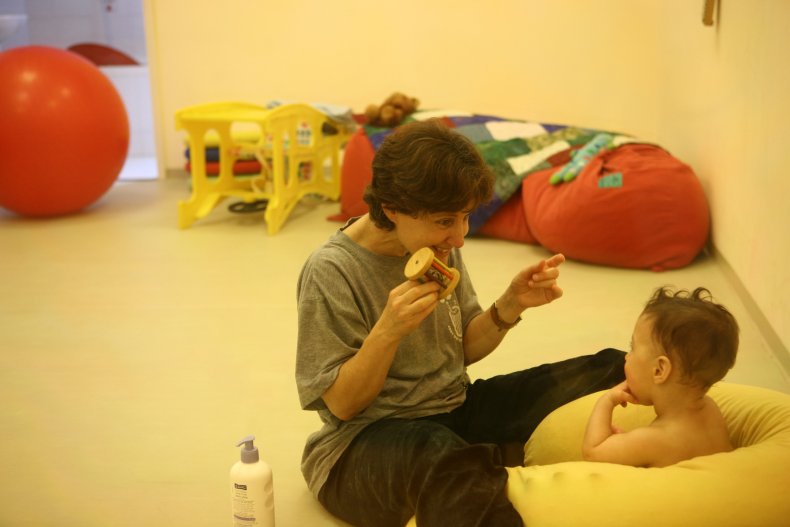Symptoms associated with autism can be detected within a child's first year of life, giving researchers optimism that therapeutic intervention and better long-term outcomes can begin as soon as a child turns 2 years old.
Those were the findings from two recent studies published in the International Journal of Pediatrics & Neonatal Care in December 2021. The research was headed by Dr. Hanna Alonim from the Mifne Center for Early Intervention in the Treatment of Autism and Bar-Ilan University's Weisfeld School of Social Work Continuing Education Unit, along with partners Dr. Ido Lieberman, Giora Schayngesicht, Dr. Hillel Braude and Dr. Danny Tayar.
Alonim, who founded and has headed the Mifne Center since 1987, also developed the ESPASSI screening scale for the detection of autism in the first year of life. She said the Mifne Center is the first and only such enterprise worldwide that treats autism in infancy, encompassing the entire nuclear family from Israel and around the world.
"Two and three decades ago when parents of children with autism were asked when they first noticed that something was irregular in their child's development, they usually expressed two typical responses: first was, 'Our child developed normally until the age of one year and then the regression began,' and second, mostly by mothers, 'I felt from the very first beginning that something was wrong with my baby, but everyone kept saying that I was a hysterical mother...'" Alonim told Newsweek.
"Our study was intended to find out whether early symptoms associated with the later development of autism could also be detected amongst infants in both of these parents' reported categories, and at what stage."
The first study, carried out between the years 1997 to 2007 with primary results
first published in the Israeli Journal of Pediatrics in 2011, analyzed video recordings of infants to detect early autism-related symptoms. A total of 110 children diagnosed with autism between the ages of 2 and 3 years were filmed by their parents as infants "before any suspicion concerning defective development arose," the study noted.

Due to all toddlers in the study being diagnosed with autism between ages 2 and 3, their first years were analyzed as a self-control group, and data was analyzed in terms of individual and combinations of variables—such as routine developmental characteristics associated with the autism spectrum.
This study included 84 boys and 26 girls between the ages of 3 and 15 months, hailing from Europe, the United States, Australia and Israel. About 98 infants, or 89 percent of study participants, showed early signs of autism between 5 and 15 months old.
Some variables or symptoms detected included: a lack of eye contact; a lack of reaction to parents voicing their children's names; excessive-passivity, or possessing a lack of crying, movement or curiosity; motor development delay; excessive activity, such as consistent restlessness, crying or preoccupation with an object; refusal to eat; and aversion to touch, among others.
The study found that among the children studied, a lack of eye contact had a correlation of 35.5 percent when combined with excessive passivity. A lack of reaction to parental presence showed a correlation of 37.3 percentage when paired with a lack of reaction to presence or voice.
The second study, conducted between 2012 to 2017, compared the effectiveness of early intervention on a group of infants aged between 12 to 24 months, and a group of toddlers aged between 24 to 36 months, who received therapeutic intervention for autism.
Researchers used the three-tier Mifne therapeutic approach, which involves a three-week intensive treatment intervention at the Mifne Center for the infant that involves family therapy; aftercare in-home treatment with supervision provided by therapists who graduated from the Mifne training program at Bar-Ilan University; and integration into kindergarten with accompanying supervision.
"The treatment was based on the bio-psycho-social approach and implicitly included not only the infants but also parents and members of the nuclear family," Alonim said. "The interventions addressed the physical, sensory, motor, emotional and cognitive aspects of development, and focused on developing attachment and leveraging infants' abilities out of curiosity and enjoyment."
The studied data involved four main categories: engagement, play, communication and functioning. Behavior, which was compared between both age groups, was measured before and after treatment.
"This study confirms the ability of infants to improve in a short period of time, due to the dynamics of neuronal growth in the brain, which forms a network of nerve cells that controls motor, sensory, emotional and cognitive functions," she said. "88.3 percent of the infants treated at their second year of life are fully functioning in mainstream schools."
Alonim said the importance of early detection has been recently acknowledged, mainly in the United States, and there exist at present a few published studies analyzing the evidence-based efficacy of very early treatment interventions for infants with an autism spectrum disorder.
An international conference about early intervention took place in November 2021 where more experts presented findings. However, Alonim said the two Mifne studies are "pioneering studies of their kind."

"The critical determinations identified in the studies is that it is indeed a window of opportunity and it makes complete sense that early detection and intervention will affect neuroanatomical development at a stage, which is most influential for the rapidly developing brain even to the extent that the full-blown manifestation of autism can be prevented from escalation," she added. "That's why bridging the gap between early detection, assessment, and intervention is crucial for the future of any infant at risk."
That includes pediatricians taking patients' concerns seriously regarding potential autism symptoms, due to that time window playing a major role in child development and the rest of their lives.
Treatment in infancy is advantageous because of the plasticity of the brain at this stage, the study states, due to accelerated growth of neurons in the first two years of life. These neurons control infants' sensory, emotional and cognitive regulation.
"Early assessment is crucial for identifying infants at risk of autism, and referring for early intervention," Alonim said. "The Mifne approach is based on the clinical claim that early treatment for autism around the age of one year when the brain develops dynamically, can alleviate the symptoms associated with autism, and positively alter the destiny of many children and their families. We are working on developing more institutes to adopt this clinical breakthrough approach. This is our mission for the next few years."

Post a Comment